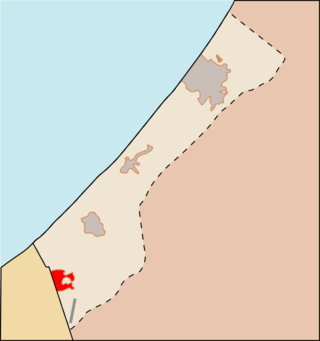
The Battle of Rafah (2009) took place between Hamas and Jund Ansar Allah in the Rafah Governorate of the Gaza Strip. Fighting between the two Palestinian militant organizations broke out on 14 August 2009, when Jund Ansar Allah's founder Abdel Latif Moussa denounced the Hamas government for supposedly failing to enforce Islamic law and for "not being any different from a secular government" since it ousted Fatah during the Battle of the Gaza Strip in June 2007. He subsequently proclaimed the establishment of the Islamic Emirate of Rafah and swore allegiance to al-Qaeda. In total, 26 people were killed and 150 were wounded during the conflict, including an 11-year-old Palestinian girl. Moussa was killed in Rafah on 15 August 2009, triggering the collapse of Jund Ansar Allah and the Islamic Emirate of Rafah.
Jund Ansar Allah was an armed radical Islamist organization operating in the Gaza Strip. It was founded in November 2008 by Sheikh Abdel Latif Moussa. On 14 August 2009, Moussa announced the establishment of the al-Qaeda inspired Islamic Emirate of Rafah in the Gaza Strip. The group criticized the ruling power, Hamas, for failing to enforce Sharia law. In response, Hamas attacked the organization, resulting in 24 people killed and a further 150 wounded. After the battle, Jund Ansar Allah ceased to exist.

Al-Nusra Front, also known as Front for the Conquest of the Levant, was a Salafi jihadist organization fighting against Syrian government forces in the Syrian Civil War. Its aim was to overthrow president Bashar al-Assad and establish an Islamic state ruled by Sharia law in Syria.

The Sinai insurgency was an insurgency in the Sinai Peninsula of Egypt, launched by Islamist militants against Egyptian security forces, which have also included attacks on civilians. The insurgency began during the Egyptian Crisis, during which the longtime Egyptian president Hosni Mubarak was overthrown in the 2011 Egyptian revolution.

The Islamic State of Iraq was a Salafi jihadist militant organization that fought the forces of the U.S.-led coalition during the Iraqi insurgency. The organization aimed to overthrow the Iraqi federal government and establish an Islamic state governed by Sharia law in Iraq.

Ansar Bait al-Maqdis, or Ansar Al-Quds, was a jihadist, extremist terrorist group based in Sinai from 2011-14.

Jund al-Aqsa, later known as Liwa al-Aqsa after 7 February 2017, was a Salafist jihadist organization that was active during the Syrian Civil War. Formerly known as Sarayat al-Quds, the group was founded by Abu Abdul 'Aziz al-Qatari as a subunit within the al-Nusra Front. The group later became independent, because al-Nusra was growing too rapidly for its resources and had suffered from fighting the Islamic State of Iraq and the Levant. On 20 September 2016 the U.S. Department of State designated Jund al-Aqsa as a terrorist organization. The group rejoined al-Nusra Front, by then renamed Jabhat Fateh al-Sham (JFS), in October 2016. However, on 23 January 2017, JFS declared that Jund Al-Aqsa was no longer part of Jabhat Fateh Al-Sham. In early February 2017, some of Jund al-Aqsa's units joined the newly formed Tahrir al-Sham, while the others refused and formed a new splinter group called Liwa al-Aqsa, and captured many towns in northern Hama and southern Idlib from other rebel groups. Following these attacks, Tahrir al-Sham launched a military operation against Liwa al-Aqsa, accusing them of being an ISIL affiliate. Following intense clashes with Tahrir al-Sham, up to 2,100 Liwa al-Aqsa militants left Idlib Province to join ISIL in Raqqa Province, by 22 February 2017.

In October 2014, the self-declared Islamic State of Iraq and the Levant (ISIL) took control of numerous government buildings, security vehicles and local landmarks in the Eastern Libyan coastal city of Derna. Although some media outlets reported the control as being absolute, rival groups like the al-Qaeda-affiliated Abu Salim Martyrs Brigade continued to control parts of the city. Clashes erupted between ISIL and an alliance of Islamist groups in June 2015, with ISIL retreating from Derna to outlying suburbs the following month. However, clashes continued between the Islamist alliance and the Tobruk-based government forces.

The Islamic State (IS) had its core in Iraq and Syria from 2013 to 2017 and 2019 respectively, where the proto-state controlled significant swathes of urban, rural, and desert territory, mainly in the Mesopotamian region. Today the group controls scattered pockets of land in the area, as well as territory or insurgent cells in other areas, notably Afghanistan, West Africa, the Sahara, Somalia, Mozambique, and the Democratic Republic of the Congo. As of 2023, large swathes of Mali have fallen under IS control.

The Sheikh Omar Hadid Brigade, also known as Islamic State in Gaza, is an Islamist militant group affiliated with the Islamic State in Iraq and the Levant that was reportedly active in the Gaza Strip around 2015. Its goals have consistently matched those of the Islamic State, in that it seeks to establish the al-Sham caliphate. As such, it opposes all forms of Palestinian nationalism while also supporting the elimination of all Jews and other ethno-religious 'infidels' from the region.

The Islamic State – Sinai Province was a branch of the terrorist Islamist group Islamic State that was active in the Sinai Peninsula of Egypt.
2013 was the year in which the jihadist group Islamic State of Iraq and the Levant adopted that name. The group expanded its territorial control in Syria and began to do so in Iraq also, and committed acts of terrorism in both countries and in Turkey.
This article contains a timeline of events from January 2015 to December 2015 related to the Islamic State of Iraq and the Levant (ISIL/ISIS). This article contains information about events committed by or on behalf of the Islamic State, as well as events performed by groups who oppose them.

Al-Qaeda in the Sinai Peninsula, or AQSP, is an Egyptian militant jihadist organization possibly formed by a merger between al-Qaeda operatives in Sinai and Ansar al Jihad. It was Al-Qaeda's branch in the Sinai peninsula, and is composed of many Al-Qaeda factions in the area. AQSP made international headlines in November 2014 when the organization pledged allegiance to the Islamic State (IS) in a nine-minute audio speech released on Twitter.
Abu Khalid al-Suri, also known as Mohamed al-Bahaiya or Abu Umayr al-Shami, was a Syrian Islamist insurgent who was often affiliated with the Muslim Brotherhood, Osama Bin Laden and the Syrian Islamist group Ahrar al-Sham. Al-Suri is also said to be a veteran, having participated in fighting in Afghanistan, Bosnia and Herzegovina, and Iraq. He was believed to be assassinated by an ISIL suicide attack in 2014, however ISIL denied involvement in the attack or regarded it as friendly fire.

Tanzim Hurras al-Din also known as Al-Qaeda in Syria, is a Salafi Jihadist organization fighting in the Syrian Civil War. The group's head, Abu Humam al-Shami was the general military commander of the defunct al-Nusra Front, and had fought for Al-Qaeda in 1990s Afghan civil war and the Iraqi insurgency. Hurras al-Din was established by the leaders of the AQ-affiliated Khorasan group and Al-Qaeda loyalists of Al-Nusra Front who opposed Jabhat Fatah al-Sham 's dissolution and merger with other Islamic groups to form Tahrir al-Sham. Abu Humam Al-Shami announced the formation of Hurras al-Din on 27 February 2018.
Opposition–ISIL conflict during the Syrian Civil War started after fighting erupted between Syrian opposition groups and the Islamic State of Iraq and the Levant (ISIL). In early January 2014, serious clashes between the groups erupted in the north of the country. Opposition groups near Aleppo attacked ISIL in two areas, Atarib and Anadan, which were both strongholds of the fundamentalist Sunni organization. Despite the conflict between ISIL and other rebels, one faction of ISIL has cooperated with the al-Nusra Front and the Green Battalion to combat Hezbollah in the Battle of Qalamoun. By 2018.
The origins of the Islamic State group can be traced back to three main organizations. Earliest of these was the "Jamāʻat al-Tawḥīd wa-al-Jihād" organization, founded by the Jihadist leader Abu Mus'ab al-Zarqawi in Jordan in 1999. The other two predecessor organizations emerged during the Iraqi insurgency against the U.S. occupation forces. These included the "Jaish al-Ta'ifa al-Mansurah" group founded by Abu Omar al-Baghdadi in 2004 and the "Jaysh Ahl al-Sunnah wa’l-Jama’ah" group founded by Abu Bakr al-Baghdadi and his associates in the same year.

The Islamic Emirate of Rafah was a short-lived unrecognized Islamic state located in Rafah. It was founded by Jund Ansar Allah when they declared independence in 2009, two years after the Hamas takeover of Gaza. It collapsed after the 2009 Battle of Rafah.
The Al-Qaeda–Islamic State conflict is an ongoing conflict between Al-Qaeda and its allied groups, and the Islamic State.













